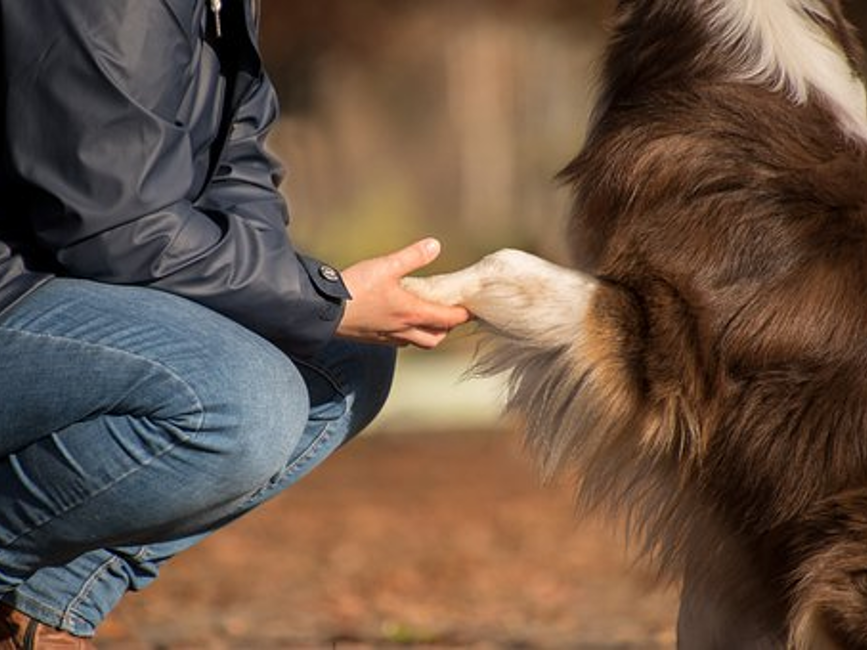The Human-Animal Bond

Humans and animals have interacted together for thousands of years. From the very first people who decided to domesticate the dog, to the present day “pioneers” that choose to keep goats and pigs in their houses, animals have played huge roles in the lives of many people. While early civilization saw them as mainly a food and fiber source or a hunting tool, modern society views them as companions, family, and best friends. The human-animal bond concept emerged in veterinary medicine as recently as the last few decades, and it has caused the companion animal industry to explode.
According to Dr. M. A. Crist, clinical assistant professor at the Texas A&M College of Veterinary Medicine & Biomedical Sciences, the inclusion of pets in many non-traditional activities, such as family ceremonies, photos, trips and gatherings, drives part of the pet industry today.
“Many of today’s pets are now considered part of the family and are treated as family members,” explains Crist. “For example, some clients have pet chickens that live in their houses. The chickens wear little pantaloons to catch their droppings in the house so that they do not make a mess. Chickens are actually becoming quite popular as family pets.”
Many pet owners include their pets in their day-to-day activities, and a lot of them include their pets in social outings. Some people raise and show pets as part of their livelihood, while others do so as a sport.
“The human-animal bond has definitely become stronger and more apparent,” says Crist. “Society is experiencing more legal issues with pets such as pets having guardians, becoming heirs to large family fortunes, or becoming disputed over in divorces. People are wanting to make sure their pets are provided for in the event of their deaths, causing the inception of companion animal centers that care for pets when their owners pass away or are no longer able to care for them.”
An example of such a facility is the Stevenson Companion Animal Life Care Center in College Station, Texas, where animals are provided life-long care in a home-like environment.
What has caused this shift in the way people view animals?
“In the past, most dogs and cats were kept outside on the family farm or ranch,” states Crist. “The dogs were sometimes used to help work the cattle or guard the sheep, and the cats were kept around to keep the mice or snake population under control. These working dogs and cats were usually fed table scraps and taken care of in passing when a veterinarian came out on a call to check a farm animal.”
As populations changed and urbanization began, dogs and cats started moving into the house, and the human-pet bond thus began to grow and strengthen. Additionally, the bond developed in food and farm animals as well.
“Youth began to get involved in FFA and 4-H programs in schools and became involved in raising and showing sheep, steers, goats, pigs, chickens, rabbits, and other food animals for competition,” explains Crist. “Many of these youth enjoyed the companionship of the farm animals that they raised and showed, and then as adults they purchased farm animals to have simply as personal pets.”
As humans and animals began living together, the bond between them became more emotional. Traditional uses of animals were questioned and modified to satisfy the want of companionship.
“As veterinarians, we are seeing a trend toward some farm pets being kept in the house as personal pets,” reveals Crist. “New miniature breeds, or “designer” breeds, are becoming popular so that these pets can be kept in smaller spaces. For example, the miniature micro pig, or teacup pig, is a pig smaller than the potbelly pig and is becoming a popular house-hold pet.”
Again, this is an instance of how far food animals have come in regards to their relationship with humans.
“Years before, food animals were raised simply for that- food- and did not have long lives,” asserts Crist. “Today, some food animals are kept as pets and will live to be quite old. As veterinarians, we are now learning some of the diseases and issues that go along with geriatric (older) food and farm animals. We have improved greatly at pain management for these animals, and we have a better understanding of the pharmacokinetics (action of drugs in the body over a period of time) of the medications we can use in these animals.”
Snakes, birds, dogs, horses, goats, cats- for all pet species, there are humans that love them. Pet owners want their pets to live long lives so that they can have as much time with them as possible. This simple need for companionship has helped to greatly improve diagnostics in veterinary medicine, as many of the diagnostics and treatments that are available to humans are now available to animals too. Owners want the best for their pets, and in return, they receive a life-long friend that might bear a ring in a wedding, pose in the family photo, or follow them room-to-room while wearing pantaloons.
ABOUT PET TALK
Pet Talk is a service of the College of Veterinary Medicine & Biomedical Sciences, Texas A&M University. Stories can be viewed on the Web at vetmed.tamu.edu/news/pet-talk. Suggestions for future topics may be directed to editor@cvm.tamu.edu.


